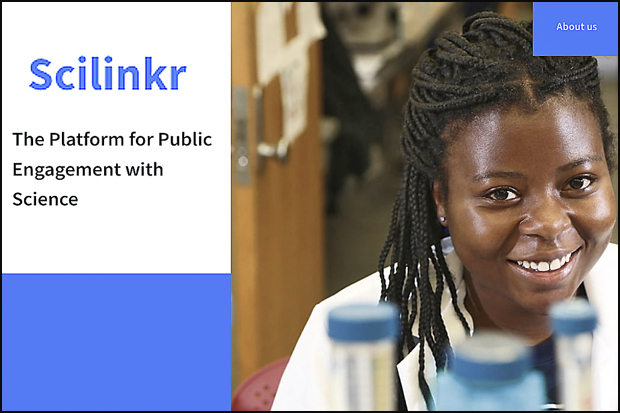Introducing SciLinkR.com
A new website aims to bring together researchers and educators to promote science.

Suppose you’re a teacher looking for a scientist to speak to your class. Where would you go to find one?
Suppose you’re a scientist with a grant that requires you to publicize your research. How would you find an outlet, such as a museum or library, where you could deliver a lecture series?
Suppose you’re a journalist who wants to find an expert on genetics. You could do a Google search, but then how would you choose from among all your options?
The answer to all of these questions is SciLinkR.com. A new national online platform launching on March 14, SciLinkR aims to be a meeting place for professionals interested in promoting and publicizing science. It will also enable users to document their outreach efforts.
While there are ways for these individuals to connect now, doing so can be burdensome and inconvenient. SciLinkR provides one central place for scientists, educators and science communicators to come together, creating new partnerships and enhancing the outreach already being done.
“The overall objective is to create networks of individuals committed to educating the public about science,” says Anique Olivier-Mason, who spearheaded the project.
SciLinkR will also emphasize connecting scientists with members of underrepresented groups in STEM fields, science, technology, engineering and math. This will be achieved by promoting the site with educators in underserved districts, who through participation in SciLinkR, can help their students become more aware, engaged and ready for professional preparation in those fields.
Olivier-Mason worked to develop SciLinkR with professors at Brandeis and Hampton University, a historically black university in Hampton, Virginia. Their work was funded by a grant from the National Science Foundation.
Olivier-Mason, the director of Education, Outreach and Diversity of the Brandeis Materials Research Science and Engineering Center (MRSEC), describes SciLinkR as “OkCupid meets LinkedIn for science.”
The OkCupid part will enable scientists, engineers, educators, librarians and science communicators to post profiles with information about their expertise, personal biography and location.
They can also indicate what they are looking for — for example, whether they want a cell biologist to talk to their kindergarten class or an aerospace engineer to speak at a planetarium.
The LinkedIn part will provide a way for users to network with collaborators in their area. Like LinkedIn, the site will recommend new contacts for users based on shared professional interests.
Meanwhile, scientists can input documentation of their outreach activities to the public.
The reports they file will be assigned a Digital Object Identifier, a string of numbers that permanently identifies a document and links to it on the web, so they can be shared and referenced by others. This will also ensure that scientists receive credit through documentation for what they’ve done.
“Currently, reports on public outreach are buried inside other reports that researchers make to grant agencies,” Olivier-Mason says. “SciLinkR’s outreach reports will greatly broaden their impact and make sure this important work gets seen and promoted.”
Finally, SciLinkR.com will allow users to upload public presentations they’ve given so others can use them as well. This site feature will promote best practices by letting researchers reuse or adapt materials and approaches that have worked for others.
Right now, Olivier-Mason says, scientists “often reinvent the wheel” even though other researchers have likely given similar talks in the past.
SciLinkR is free for users and hopes to quickly build a national presence. By 2020, project organizers expect to have more than a thousand users.
Categories: Research, Science and Technology





